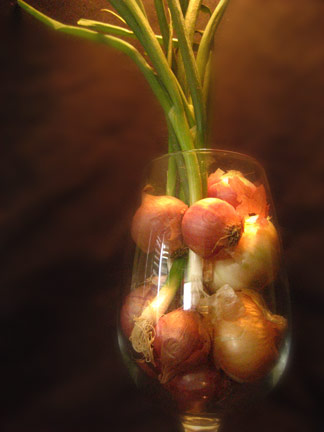Not all onions make you cry : The flavour secrets of onions

I’m a little crazy. I took a perfectly good Saturday morning and used it to conduct an onion tasting experiment. There was much tearing as I sniffed at each of the 10 specimens, my partner was snickering at me from his computer the whole time. Onions are a culinary staple across cuisines, so why don’t we get to know how best to them? People even eat them like apples… crazy people. They are used in stock, stir-fry, stew, salad, on burgers, deep fried and most spectacularly by the French in a Tarte L’oignon. There are 700 Allium (onion genus) species on the planet, each flavour profile changes depending on size, age of the onion, soil & growing conditions. Bermuda, Texas, Maui, Vidalia and Walla Walla onions are all specialty sweet onions that are grown is specific regions of the world. Some of them are just marketing ploys and you could find an onion just as interesting at your local farmers market for cheaper. So, it’s good to narrow it down and learn about the onions of your region. Onion expertise is helpful both for improving your cooking and knowing when you can opt for a cheaper onions in a recipe and still make delicious dishes.

The Onion Flavour Rainbow…
Here are a sommeliers notes on common onions and what they are best used for. I took down the characteristics of each onion; aroma and taste in both raw and caramelized/cooked states.
Cooking onions through broiling or sauteing in butter converts molecules to sugar caramelizing them. For these tests ‘cooked’ means that I broiled them (425F for 25 min) so that I could test the flavour without butter influencing in the result. I’ve given each note a strength rating. St = flavour strength and Ht = Heat/Bite. Rated from 1– 4 (mild=1)
Our mildest onions, green onions and chives impart a grassy, fresh taste to any dish, I mostly use them raw.
Chive
Raw Nose – buttery, cinnamon, floral, grassy, amazing nose. St -2
Raw Taste – bitter, buttery, earthy, grassy and very delicate. St – 1
Raw Heat –Very light heat, more bitter than hot Ht – 1
Cooked– Broiling these just made them lose their lovely, fresh subtlety, but they were buttery at least.
Green onion/Scallions (Same thing)
Raw Nose – earthy, grassy St – 1
Raw Taste – very sweet, fresh and grassy, with a nice peppery, oily quality. St -1 Ht – 1
Cooked Nose – Notable tanginess when cooked, still held its grassy, sweet, caramel nature. St -1
Cooked Taste – Tangy, sweet and charcoal, in a good way. St – 1 Ht=0
Leeks are my favourite Allium; complex flavour, best cooked low and slow to bring out maximum sweetness, deep frying to crispy is another great technique.
Leek
Raw Nose – buttery, cinnamon, grassy and slightly hot, really an amazing aroma. St -2
Raw Taste – Texture is the difference with raw leeks, they are usually a bit too oily to serve raw. Burnt, green pepper, buttery, sweet. St -4 Ht – 1
Cooked Nose – Very mild and uniquely floral scent
Cooked Taste – Sweet, buttery pear, really interesting and different than most onions. Melts in your mouth. Ht=0
Cippolini
Raw Nose – mild butter, sweetness St – 2
Raw Taste – buttery, peachy very mild and interesting Ht – 1 St-1
Cooked Nose – Really neat sherry aroma (nutty, fruity). St – 2
Cooked Taste – Quite a lot sweeter than raw, tangy, melon taste was really cool. St – 2 Ht=0
Pearl onions are a lot of prep work! I use these for their shape and texture in stews or pickles.
Pearl
Raw Nose – mild buttery St – 1
Raw Taste – Mild oniony, St-1, Ht-1
Cooked Nose – Gorgeous nutty, buttery aroma
Cooked Taste – Melt in your mouth buttery, caramel, sweet as hell, great texture and look. Ht=0
White onions are best raw, but you can easily substitute a yellow onion that’s been soaked in water to soften its bite.
White (fresh from the farmers market with green stem attached still, medium sized)
Raw Nose – mild, clean and grassy St – 1
Raw Taste –mild floral, cinnamon, very clean St – 1 Ht – 1
Cooked Nose – nutty, caramel, butter. St – 1
Cooked Taste – Very subtle, mostly buttery and quite sweet Ht – 1
Bullets can be very expensive, great for raw recipes.
Bullet Onion (pink and torpedo shaped, medium sized from farmers market)
Raw Nose – clean (very fresh onion) and nutty St – 1
Raw Taste – clean and peppery, no need to soak this one, great in salads. St – 2 Mild pepper bite Ht – 2
Cooked Nose – bitter, earthy, grassy, very rich aroma St – 3
Cooked Taste – mild, clean, caramel with a bit of sweetness Ht=0
Yellow
Raw Nose – Hot as hell with an interesting aroma of popcorn. St – 4
Raw Taste – Sour, green pepper, spicy, you can really cry for this one. St – 2 Ht – 4!
Cooked Nose – mild and caramel St – 2
Cooked Taste – This is the work horse of all cooking onions, perfect for any stock. When cooked becomes very sweet the longer you cook it on low heat and gets nice and buttery. Ht -1
Red
Raw Nose – wine, sour, earthy, very, very hot. This was the strongest onion of the lot. St – 4
Raw Taste – green peppery, hot, sweet. I would soak this one in water before serving raw to remove some of the bite. HOT! Ht – 4
Cooked Nose – sweet tomato-like, burnt and still a bit of sulfur/heat left. This onion must have been older. St – 3
Cooked Taste – very sweet, buttery and light caramel, bit of heat still left, good if want an oniony bite in a recipe Ht – 2
Shallots are best cooked as they can be very hot, my least favourite onion.
Shallot, golden
Raw Nose –I couldn’t even smell anything, but it was sooo bloody hot, the sulfur knocked me on my ass.
Raw Taste – Bitter, peppery, clean but too hot to be pleasant
Raw Heat- Ht – 4
Cooked Nose – bitter, sour, peppery, caramel, quite strongly St – 3
Cooked Taste – mild, buttery, slight caramel medium sweetness Ht=0
Learnings…
My findings were very exciting (perhaps only to me), onions vary a lot in sweetness level and heat. Age and season matters! Fresh onions tend to be sweeter; storage onions get hotter and stronger in flavour over time. Sweet onions are clean and sweetest tasting raw when bought in their growing season Spring to early Fall depending on the variety. Sweet or newly picked onions soften easily when cooked and will melt in your mouth if you caramelize them, quite an amazing event in itself. The really interesting finds in this experiment were the subtle flavour nuances of each onion. I treated each with the respect of a fine wine and jotted down subtle flavour characteristics if they revealed themselves to me; anything from notes of cinnamon, fresh grass, melon or nuttiness.
How to soften the raw bite…
To soften the sulfurous bite (heat) of any onion, soak in water for 15 min after slicing (great to tone down any raw onion for a salad or on a burger). Shallots were the hottest of all the onions raw, it burned!
Onions are as varied as the wind. Mostly, you can substitute any onion called for in a recipe for any other that you like and I would encourage you to try out different varieties. Hopefully, you’ve learned something new about a vegetable that you use everyday. Next time you use an onion in a recipe, note the sweetness and heat level to start building your own sensory palate of local onion species.
If you want to know everything there is to know about onions, this is a really interesting cookbook…
Onions, onions,onions. Delicious recipes for the world’s favorite secret ingredient. By Linda and Fred Griffith
